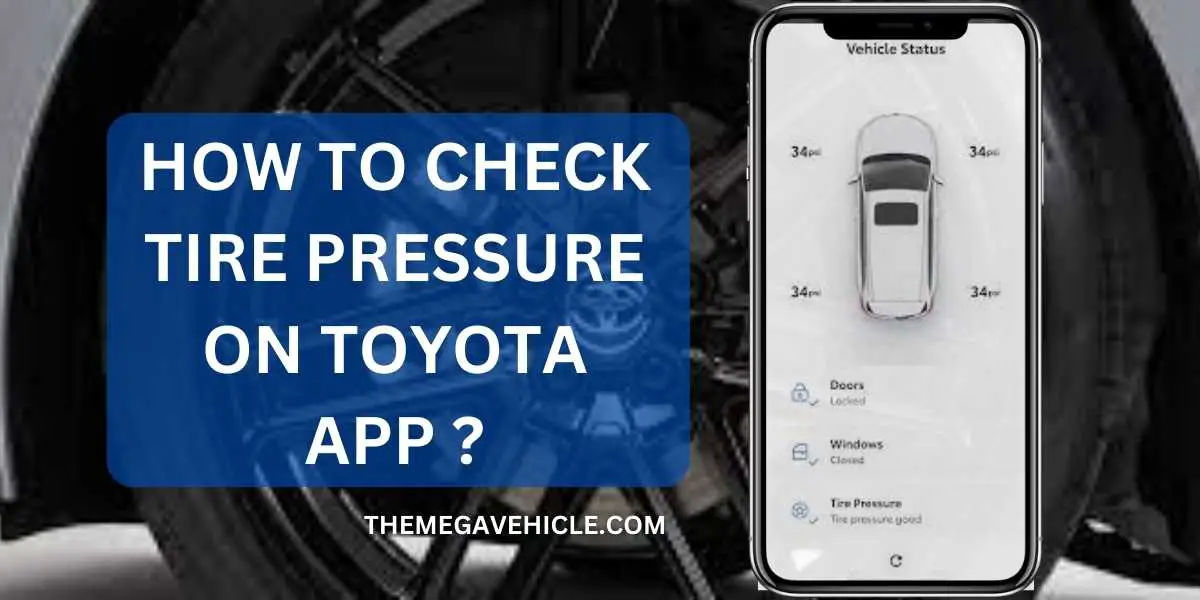How to Check Tire Pressure on Toyota App?

Maintaining properly inflated tires is a cornerstone of optimal vehicle performance, safety, and fuel efficiency. Underinflated tires can lead to a cascade of issues, including premature wear and tear, reduced handling and responsiveness, and increased fuel consumption. These issues can not only compromise your vehicle’s performance but also pose potential safety hazards.
Overinflated tires, while less common, can also lead to dangerous situations. Excessive tire pressure can cause the tire to lose traction, increasing the risk of a blowout and compromising stability, especially during maneuvers or sudden changes in direction.
Maintaining Optimal Tire Pressure with the Toyota App
Fortunately, many Toyota vehicles come equipped with a Tire Pressure Monitoring System (TPMS) that can monitor the pressure of each tire and alert the driver if any tire is underinflated. The Toyota app, which is available for both iOS and Android devices, can be used to check the tire pressure readings for each tire on your vehicle.
Here’s a step-by-step guide on how to check tire pressure on the Toyota app:
Step 1: Download and Install the Toyota App
Before embarking on your tire pressure monitoring journey using the Toyota app, ensure you have the app installed on your compatible smartphone. The Toyota app is readily available for both iOS and Android devices, providing a convenient platform to access valuable vehicle information.
Downloading the Toyota App for iOS Devices:
- Launch the App Store: Access the App Store on your iOS device.
- Locate the Toyota App: Utilize the search bar to find the official Toyota app or “myToyota” (depending on your region).
- Identify the Official App: Select the verified Toyota app from the search results.
- Initiate Download and Installation: Tap on the “Get” button to commence the app download and installation process.
- Create or Sign In to Your Account: Once the app is installed, open it and either create a new account or sign in to your existing account.
Downloading the Toyota App for Android Devices:
- Access the Google Play Store: Launch the Google Play Store on your Android device.
- Locate the Toyota App: Utilize the search bar to find the official Toyota app or “myToyota” (depending on your region).
- Identify the Official App: Select the verified Toyota app from the search results.
- Initiate Download and Installation: Tap on the “Install” button to commence the app download and installation process.
- Create or Sign In to Your Account: Once the app is installed, open it and either create a new account or sign in to your existing account.
Compatibility Requirements:
The Toyota app boasts compatibility with a wide range of iOS and Android devices. However, it’s always advisable to verify the app’s compatibility requirements before proceeding with the download and installation process.
- iOS: The Toyota app seamlessly operates on iOS devices running iOS 10.0 or later.
- Android: The Toyota app functions effectively on Android devices running Android 5.0 or later.
With the Toyota app successfully installed on your compatible smartphone, you’re now equipped to embark on the next crucial step: connecting your Toyota vehicle to the app.
Step 2: Connect Your Toyota Vehicle to the Toyota App
After successfully downloading and installing the Toyota app on your compatible smartphone, it’s time to connect your Toyota vehicle to the app. This crucial step enables the app to seamlessly access your vehicle’s data, including real-time tire pressure readings.
Requirements for Vehicle Connectivity:
To establish a connection between your Toyota vehicle and the Toyota app, ensure you have the following prerequisites:
- Toyota Connected Services Compatibility: Your Toyota vehicle must be equipped with Toyota Connected Services, a suite of advanced features that provide connectivity and convenience.
- Installed Toyota App: The Toyota app should be successfully installed on your compatible smartphone. Refer to Step 1 for detailed download and installation instructions.
- Active Data Connection: Your smartphone must have an active data connection to facilitate communication with the Toyota app.
Connecting Your Vehicle to the Toyota App:
- Launch the Toyota App: Access the Toyota app on your smartphone and sign in to your account.
- Vehicle Selection: Select your Toyota vehicle from the list of registered vehicles associated with your account.
- Follow On-screen Instructions: Carefully follow the on-screen instructions provided by the app to establish a connection between your vehicle and the app. This process may involve entering your vehicle’s VIN (Vehicle Identification Number) and creating a Toyota Connected Services account if you haven’t already.
- Expanded Features and Data Access: Once your vehicle is successfully connected, you’ll gain access to a wide range of features and data, including real-time tire pressure readings, providing you with valuable insights into your vehicle’s health and performance.
Troubleshooting Vehicle Connectivity Issues:
If you encounter any difficulties connecting your vehicle to the Toyota app, try these troubleshooting steps:
- Verify Toyota Connected Services: Check if your vehicle is equipped with Toyota Connected Services. Consult your vehicle’s owner’s manual or contact Toyota customer support for confirmation.
- Check Internet Connectivity: Ensure your smartphone has an active and stable internet connection. Try restarting your Wi-Fi or mobile data connection.
- Enable Bluetooth: Verify that the Bluetooth connection on your smartphone is enabled. This is essential for establishing a communication link between your phone and the vehicle.
- Restart Devices: Restart your smartphone and Toyota vehicle. This can sometimes resolve temporary glitches or connection issues.
- Seek Toyota Support: If the connection issue persists, contact Toyota customer support for further assistance. Their experts can provide in-depth troubleshooting steps and identify potential underlying issues.
With your Toyota vehicle successfully connected to the Toyota app, you’re now ready to proceed to the next step: checking your tire pressure using the app.
Step 3: Accessing the Tire Pressure Monitoring System (TPMS)
With your Toyota vehicle successfully connected to the Toyota app, you’ve unlocked the gateway to real-time tire pressure monitoring through the Tire Pressure Monitoring System (TPMS). This innovative system utilizes sensors mounted on each tire to continuously monitor pressure levels and provide timely alerts if any tire is underinflated.
Accessing Tire Pressure Information:
- Launch the Toyota App: Access the Toyota app on your smartphone and sign in to your account.
- Vehicle Selection: Select your Toyota vehicle from the list of registered vehicles associated with your account.
- Navigate to Service Tab: Tap on the “Service” tab located at the bottom of the screen.
- Access Tire Center: Scroll down to the “Tire Center” section and select “Tire Maintenance” from the menu.
- Real-Time Tire Pressure Readings: On the Tire Maintenance page, you’ll be presented with the current tire pressure readings for each tire on your vehicle.
- Pressure Units: The app conveniently displays the tire pressure readings in both pounds per square inch (psi) and kilopascals (kPa), catering to your preferred units of measurement.
- Recommended Pressure Range: The app will indicate whether the current tire pressure readings fall within the recommended range for your vehicle.
Understanding TPMS Alerts:
The TPMS acts as your vigilant guardian, alerting you to any tire pressure concerns. If any tire is underinflated, the TPMS will trigger a warning light on your vehicle’s dashboard and send a notification on the Toyota app. The app will pinpoint the affected tire and provide the current pressure reading.
Responding to TPMS Alerts:
When you receive a TPMS alert, don’t delay in taking action. Promptly check and inflate the underinflated tire to the recommended pressure level. Underinflated tires can compromise vehicle safety, fuel efficiency, and tire longevity.
By regularly checking tire pressure using the Toyota app and diligently responding to TPMS alerts, you can maintain optimal tire pressure levels, contributing to a safer, more fuel-efficient, and enjoyable driving experience. Remember, properly inflated tires are essential for your vehicle’s overall well-being and performance.
Step 4: Checking and Adjusting Tire Pressure
With the real-time tire pressure readings readily available on the Toyota app, it’s time to take the next step: checking and adjusting tire pressure as needed. Maintaining proper tire pressure is a cornerstone of optimal vehicle performance, safety, and fuel efficiency.
Checking Tire Pressure with a Tire Gauge:
- Determine Recommended Tire Pressure: Before you begin, locate the tire pressure placard on the driver’s door jamb or consult your vehicle’s owner’s manual to determine the recommended tire pressure level for your specific vehicle. This information is crucial for ensuring proper inflation.
- Remove Tire Valve Cap: Locate the tire valve stem and remove the protective cap. This will allow you to access the tire’s air valve.
- Attach Tire Gauge: Firmly attach the tire gauge to the valve stem. The gauge should make a hissing sound as it forms a tight seal.
- Read Tire Pressure: Gauge the tire pressure by reading the measurement displayed on the gauge. This reading will indicate the current air pressure in the tire.
- Compare to Recommended Pressure: Compare the measured tire pressure to the recommended pressure level as determined in step 1. If the tire pressure is too low or too high, you’ll need to adjust it accordingly.
- Inflating or Deflating Tires: If the tire pressure is too low, use an air compressor or tire pump to inflate the tire until it reaches the recommended level. Conversely, if the tire pressure is too high, slowly release air from the tire until it reaches the recommended level.
Tips for Checking and Adjusting Tire Pressure:
- Check Tire Pressure When Cold: Tire pressure increases as the tires heat up. For an accurate reading, check tire pressure when the tires are cold, preferably first thing in the morning or after the vehicle has been parked for several hours.
- Regular Tire Pressure Checks: Make it a habit to check tire pressure regularly, especially before long trips or when the weather conditions change significantly. This proactive approach helps identify and address potential issues before they compromise your vehicle’s performance or safety.
- Never Exceed Maximum Tire Pressure: Always adhere to the maximum tire pressure specified on the tire placard. Exceeding the recommended pressure can lead to tire damage and safety hazards.
- Use an Accurate Tire Gauge: Employ a tire gauge that is accurate and calibrated to ensure reliable pressure readings. A faulty gauge can provide misleading information and lead to incorrect tire inflation.
- Inflate or Deflate Tires Slowly: When inflating or deflating tires, take it slow and avoid making sudden or drastic changes in pressure. This gradual approach helps maintain tire integrity and prevent over-inflation or under-inflation.
Recommended Tire Pressures for Different Conditions
Tire pressure recommendations may vary depending on the vehicle model, tire size, and load conditions. Consult your vehicle’s owner’s manual or tire placard for the specific recommended tire pressure levels for your vehicle. Here are some general guidelines:
- Standard Driving Conditions: The recommended tire pressure for everyday driving is typically around 32-35 psi (pounds per square inch).
- Heavily Loaded Vehicle: If your vehicle is carrying a heavy load, you may need to increase the tire pressure slightly to compensate for the additional weight. Consult your owner’s manual for the specific recommended pressure for loaded conditions.
- Cold Weather Conditions: Tire pressure can decrease as the temperature drops. Check tire pressure more frequently during cold weather and inflate tires to the recommended level if necessary.
- Hot Weather Conditions: Tire pressure can increase as the temperature rises. Check tire pressure before starting a long trip in hot weather and release air if necessary to avoid overinflation.
Benefits of the Toyota App for Tire Pressure Monitoring
The Toyota app offers several benefits for tire pressure monitoring, making it a valuable tool for ensuring optimal tire performance, vehicle safety, and fuel efficiency. Here are some of the key benefits of using the Toyota app for tire pressure monitoring:
- Real-time Tire Pressure Insights: The Toyota app grants you real-time access to tire pressure readings for each tire on your Toyota vehicle. This real-time transparency enables you to identify any discrepancies in tire pressure levels, whether it’s underinflation or overinflation, empowering you to take prompt corrective action.
- TPMS Alerts for Timely Interventions: The Toyota app seamlessly integrates with your vehicle’s Tire Pressure Monitoring System (TPMS), providing timely alerts when any tire pressure falls below a safe level. These alerts serve as your guardian angels, keeping you informed about tire pressure issues before they escalate into potential hazards.
- Effortless Tire Pressure Monitoring at Your Fingertips: Gone are the days of lugging around a tire gauge and struggling to accurately measure tire pressure. The Toyota app transforms tire pressure monitoring into a hassle-free experience, allowing you to check tire pressure readings anytime, anywhere, using your smartphone.
- Promoting Tire Longevity and Cost Savings: Maintaining proper tire pressure is the key to extending tire life and minimizing premature wear and tear. By regularly monitoring tire pressure with the Toyota app, you can ensure that your tires are operating at optimal pressure levels, potentially saving you money on tire replacements in the long run.
- Maximizing Fuel Efficiency and Environmental Consciousness: Properly inflated tires play a crucial role in optimizing fuel efficiency by reducing rolling resistance. By monitoring tire pressure regularly with the Toyota app, you can ensure that your tires are properly inflated, potentially saving you money on fuel costs while also reducing your environmental impact.
- Enhancing Vehicle Safety for a Smoother Ride: Maintaining proper tire pressure is fundamental to vehicle safety. Underinflated tires can lead to premature wear, reduced handling, and increased risk of blowouts, while overinflated tires can affect vehicle stability and handling. By regularly monitoring tire pressure with the Toyota app, you can help ensure optimal tire performance and contribute to a safer driving experience.
With its user-friendly interface and comprehensive tire pressure monitoring features, the Toyota app empowers you to take control of your vehicle’s tire health. By embracing the convenience and effectiveness of the Toyota app, you can reap the rewards of optimal tire performance, enhanced vehicle safety, and improved fuel efficiency, ensuring a smooth and enjoyable driving experience for years to come.
The Bottom Line
The Toyota app has transformed tire pressure management into a hassle-free and convenient experience. By following the steps outlined in this guide, you can effectively utilize the app to check, adjust, and maintain optimal tire pressure for your Toyota vehicle. Remember, regular tire pressure checks are crucial for preventing potential problems and ensuring a safer, more enjoyable driving experience. Embrace the convenience of the Toyota app and keep your tires in top condition for years to come.






